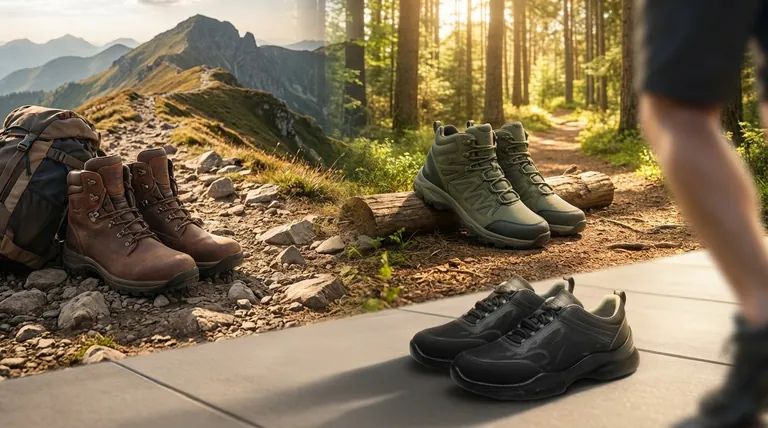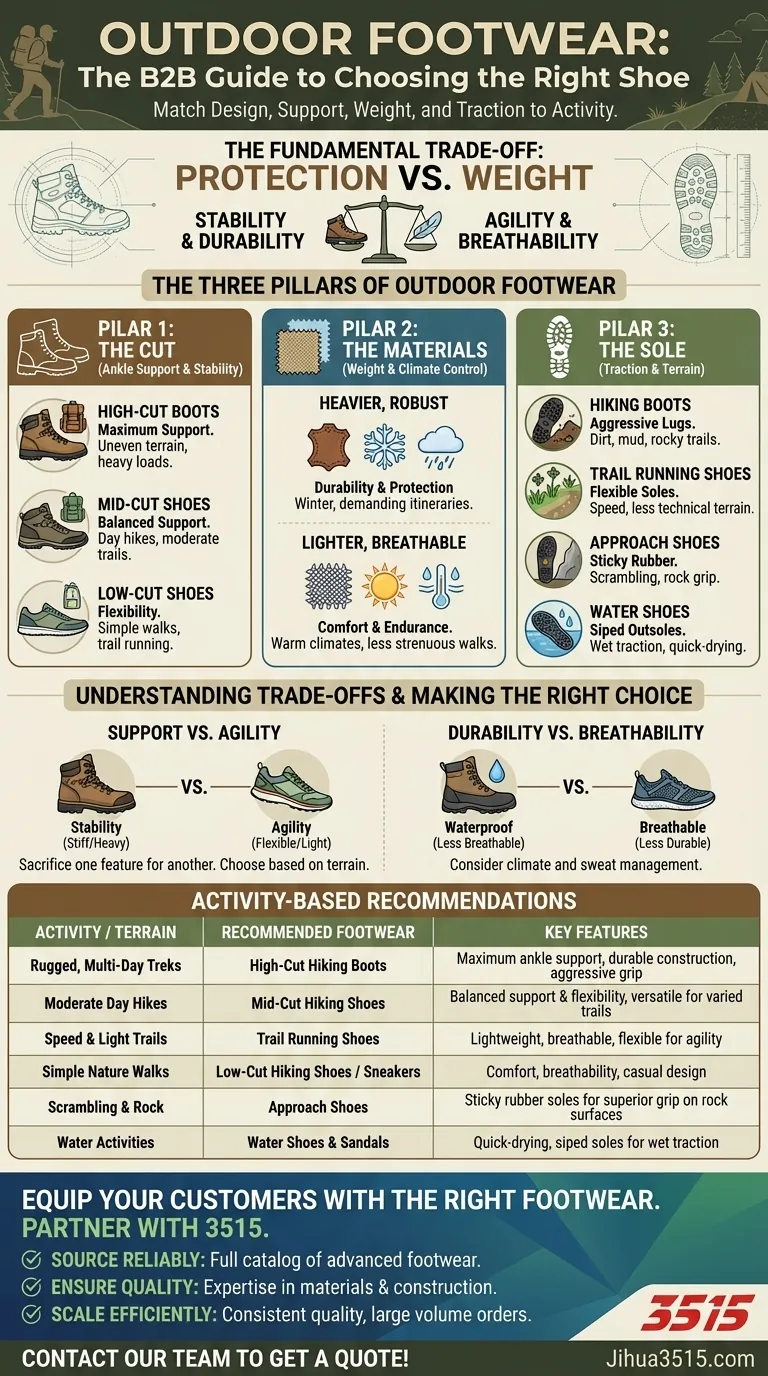Choosing the right outdoor shoe depends entirely on your specific activity, terrain, and climate. For demanding mountain trails, you need robust, high-cut boots, whereas for simple nature walks in warm weather, a lightweight, low-cut shoe is far more suitable. The key is to match the shoe's design—its support, weight, and traction—to the demands of your adventure.
The core principle of selecting outdoor footwear is not about finding one "best" shoe, but about understanding the fundamental trade-off between protection and weight. Your ideal choice will balance the stability you need for the terrain against the lightness and breathability required for comfort and endurance.

The Three Pillars of Outdoor Footwear
To make an informed decision, you must evaluate a shoe based on three critical factors: its cut (support), its materials (weight and breathability), and its sole (traction).
Pillar 1: The Cut (Ankle Support & Stability)
The height of the shoe's collar is the primary indicator of its intended use and the level of support it provides.
- High-Cut Boots: These extend above the ankle, offering maximum support. They are designed for medium to high-difficulty trails with uneven terrain, especially when carrying a heavy pack.
- Mid-Cut Shoes: Ending at the ankle, these offer a balance of support and flexibility. They are an excellent choice for easier, well-maintained routes and day hikes.
- Low-Cut Shoes (Bassa): These resemble standard sneakers and provide the most flexibility but minimal ankle support. They are ideal for simple walks in nature, trail running, or even city use.
Pillar 2: The Materials (Weight & Climate Control)
A shoe's construction dictates its suitability for different weather conditions and climates.
- Heavier, Robust Shoes: Often made with leather and waterproof membranes, these are built for demanding winter and mountain itineraries. They prioritize durability and protection from the elements over breathability.
- Lighter, Breathable Shoes: Typically constructed with synthetic mesh fabrics, these are perfect for warm climates and less strenuous walks. They allow moisture to escape, keeping your feet cooler and drier.
Pillar 3: The Sole (Traction & Terrain)
The outsole is your connection to the ground. Different activities demand different types of non-slip soles.
- Hiking Boots: Feature deep, aggressive lugs for gripping dirt, mud, and rock on varied trails.
- Trail Running Shoes: Have flexible soles with multi-directional lugs designed for moving quickly over less technical terrain.
- Approach Shoes: A hybrid between a hiking shoe and a climbing shoe, they have sticky rubber soles for scrambling over rock.
- Water Shoes & Sandals: Designed with siped outsoles to channel water away and provide grip on wet surfaces.
Understanding the Trade-offs
Choosing footwear is always a compromise. Prioritizing one feature means sacrificing another, and understanding this is key to avoiding mistakes.
Support vs. Agility
A heavy, high-cut boot provides exceptional ankle support, preventing twists on rocky ground. However, this stability comes at the cost of weight and stiffness, which can slow you down. A lightweight trail runner offers superior agility but provides little protection against ankle rolls.
Durability vs. Breathability
Robust, waterproof boots are highly durable and keep your feet dry from external moisture like rain or stream crossings. The trade-off is that they are less breathable, which can lead to sweaty, uncomfortable feet in warm weather.
Function vs. Appearance
While style is a valid consideration, for any activity involving prolonged walking or hiking, function must be the priority. Wearing inappropriate footwear is a direct path to discomfort, blisters, and potential injury.
Making the Right Choice for Your Goal
Select your footwear based on the most demanding conditions you expect to face on your adventure.
- If your primary focus is stability on rugged, multi-day treks: Choose a high-cut, robust hiking boot for maximum ankle support and durability.
- If your primary focus is versatility for day hikes on moderate trails: A mid-cut hiking shoe provides the ideal balance of support and flexibility.
- If your primary focus is speed and moving light on well-maintained paths: Opt for a dedicated trail running shoe to maximize agility and breathability.
- If your primary focus is casual comfort for simple nature walks: A low-cut hiking shoe or a versatile all-terrain sneaker is perfectly sufficient.
Ultimately, a great outdoor journey begins with the right foundation for your feet.
Summary Table:
| Activity / Terrain | Recommended Footwear Type | Key Features |
|---|---|---|
| Rugged, Multi-Day Treks | High-Cut Hiking Boots | Maximum ankle support, durable construction, aggressive grip |
| Moderate Day Hikes | Mid-Cut Hiking Shoes | Balanced support & flexibility, versatile for varied trails |
| Speed & Light Trails | Trail Running Shoes | Lightweight, breathable, flexible for agility |
| Simple Nature Walks | Low-Cut Hiking Shoes / Sneakers | Comfort, breathability, casual design |
| Scrambling & Rock | Approach Shoes | Sticky rubber soles for superior grip on rock surfaces |
| Water Activities | Water Shoes & Sandals | Quick-drying, siped soles for wet traction |
Ready to Equip Your Customers with the Right Footwear?
As a large-scale manufacturer, 3515 produces a comprehensive range of high-performance outdoor footwear for distributors, brand owners, and bulk clients. Our production capabilities encompass all types of shoes and boots, from rugged high-cut hiking boots to lightweight trail runners, ensuring you get the perfect product for your market.
Partner with us to:
- Source Reliably: Access a full catalog of technically advanced outdoor footwear.
- Ensure Quality: Benefit from our expertise in materials, construction, and sole technology.
- Scale Efficiently: Meet large-volume orders with consistent quality and competitive pricing.
Let's discuss your specific needs. Contact our team today to request a catalog or get a quote!
Visual Guide

Related Products
- Wholesale Breathable Training Shoes Custom Athletic Footwear Manufacturer
- Durable Rubber-Soled Utility Shoes for Wholesale & Custom Brand Manufacturing
- Wholesale Training Shoes with Dial Lacing System Custom OEM Manufacturing
- Wholesale Durable Camouflage Canvas Shoes with High-Traction Cleated Rubber Sole
- Premium KPU Athletic Safety Shoes for Wholesale
People Also Ask
- How do non-slip athletic shoes differ from regular athletic shoes? Discover the Grip Technology
- Why are running shoes and walking shoes not interchangeable? Avoid Injury with the Right Footwear
- What are the characteristics of canvas as a shoe material? A Guide to Lightweight, Breathable Footwear
- Does more ground contact area mean better support? Unlock the Secrets of Stable Footwear
- What should be considered when choosing smart trainers for business casual? A Guide to Professional Style



















